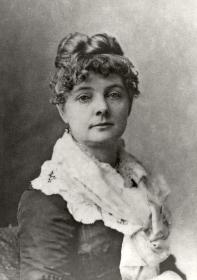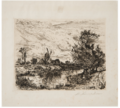Mary Nimmo Moran facts for kids
Quick facts for kids
Mary Nimmo Moran
|
|
|---|---|
 |
|
| Born |
Mary Nimmo
May 16, 1842 |
| Died | September 25, 1899 (aged 57) |
| Resting place | Goose Pond, East Hampton, New York |
| Known for | Etching |
| Spouse(s) | |
Mary Nimmo Moran (born May 16, 1842 – died September 25, 1899) was an American artist from the 1800s. She was known for making beautiful landscape prints, especially using a technique called etching. She showed that women could have a successful career in art even while being married and having a family.
Mary Nimmo Moran was one of the first important landscape artists. By 1880, she was famous for her landscape etchings. She created about 70 landscape etchings. These included scenes from England, Scotland, Long Island, New York, New Jersey, Florida, and Pennsylvania. In 1881, she made history. She became the first woman and one of only eight Americans to join London's Royal Society of Painter-Printmakers. Her etching called View of Newark from the Meadows is now in The Newark Museum of Art. She was one of the first American artists to explore etching.
Mary was born in Scotland. When she was five, she moved to the United States with her father and brother. They settled in Philadelphia. She later married another American artist, Thomas Moran, and they had a family.
Contents
Mary Nimmo Moran's Early Life and Art Journey
Mary Nimmo was born in Strathaven, Scotland, on May 16, 1842. Her parents, Mary and Archibald Nimmo, were weavers. Weaving colorful wool was a main way for people in Strathaven to earn a living.
When Mary was five, in 1847, her mother passed away. Her father, Archibald, then took Mary and her brother to the United States. They settled in Crescentville, Philadelphia, Pennsylvania, in 1858. In 1860, she began studying art at the Pennsylvania Academy of the Fine Arts. Her neighbor, Thomas Moran, who was becoming a known artist, also studied there.
In 1862, Mary and Thomas got married. They moved to Philadelphia and started a family. Their son, Paul Nimmo Moran, was born in 1864. Their first daughter, Mary Scott, was born in 1868. Their third daughter, Ruth Bedford, was born in 1870.
In 1866, the Morans traveled to Europe to study art. They stayed briefly in England. Then they moved to France. In Paris, they rented a studio for nine months near the Luxembourg gardens. Mary painted street scenes of Paris. She also sketched in Fontainebleau and the Seine Valley. Next, they went to Italy. They loved the ancient city of Baise. They traveled through Italy, visiting places like Rome, Florence, Bologna, and Milan. They also sketched Lake Como. After that, they went through St. Gotthard and the Alps. Then they returned to Paris.
In 1872, they moved to Newark, New Jersey. Mary painted a view of the Hackensack Meadows. This oil painting, created in 1879, was called Newark from the Meadows. It was one of the earliest paintings to show an industrial scene in America.
Discovering Etching
Mary started painting to be a better companion to her husband on his sketching trips. She used watercolors and oil paints. Then, in 1879, her husband showed her how to etch. Etching is a technique where you draw directly onto a copper plate.
Her first etching was a Florida landscape. She created it from memory after a family trip in 1877. She made most of her etchings near her homes. This was because her family duties limited her travel. Her paintings and etchings clearly show her love for nature. Etching quickly became her favorite art form. Her etchings were praised for being direct and bold. They were very different from other art at the time.
The New York Etching Club invited the Morans to show their art. This was for an American display at an international exhibition. It was for the new Royal Society of the Painter-Etchers. Mary showed four etchings there. These included Easthampton, Barnes, L.I., An Old Homestead at Easthampton, Long Island: Solitude, and Long Island Twilight. She was the only woman among the 65 original members.
She was elected to the Society of Painter-Etchers of New York in 1879. In 1881, she and her husband were invited to join the Royal Society of Painters and Etchers of Great Britain. This allowed her to show her work to a wider audience. She was the only woman among the 65 original members chosen for London's Royal Society of Painter-Printmakers. Her prints were known for their boldness and originality. The British critic John Ruskin collected her work. She often showed her art at the American Society of Painters and Etchers.
Mary Nimmo Moran often signed her etchings "M. Nimmo Moran" or "M. N. Moran". This made many people, including art committees, think she was a male artist. Her etchings received great praise for being direct and bold.
Life in New York and East Hampton
The Moran family moved to Newark, New Jersey in 1872. In June 1881, they moved to New York City. Mary found inspiration in the city. She captured the changing city in her art. In 1882, the Moran family took another trip to England and Scotland. Mary created art there, including Cochrane's O'The Craig-Strathaven. This was a tribute to the town where she was born.
In 1884, they moved to East Hampton, Long Island. This town became the subject of many of Mary Nimmo Moran's most successful etchings. The Moran home in East Hampton became a hub for many artists. Today, it is a National Historic Landmark. It is also part of the East Hampton Village District, a historic area listed on the National Register of Historic Places.
Her paintings were shown sometimes at the National Academy of Design. Her work was also presented at the Society of American Artists from 1879-1899. It was also shown at the Pennsylvania Academy of the Fine Arts.
Fifty-four of her etchings were featured in a large exhibition. This was called the Mammoth Exhibition of Women Printmakers. It took place at the Museum of Fine Arts in Boston from November 1 to December 31, 1887.
Mary Nimmo Moran also showed her work at the Woman's Building. This was at the 1893 World's Columbian Exposition in Chicago, Illinois.
People described Mary Nimmo Moran as charming, friendly, bright, modest, and humble. She was also very knowledgeable in many different art forms. In the summer of 1950, her etchings were shown at the Smithsonian Institution in Washington D.C.
Later Life and Legacy
Mary Nimmo Moran died from typhoid fever in 1899. She had been caring for her daughter Ruth, who also had the disease. Mary was buried next to Goose Pond. This pond was a subject in many of her etchings. It was near her home in East Hampton.
Auction Record
On June 9, 2011, Swann Galleries sold Mary Nimmo Moran's Long Island Landscape. This was an 1880 oil painting. It was her first painting to be sold at auction. It sold for $64,800.
Artworks
| Name | Date | Medium | Size |
|---|---|---|---|
| Across the Water | ca. 1880–1890 | etching | 5 7/8 x 8 in. (14.9 x 20.2 cm) |
| The Bay | ca. 1880–1890 | etching | 8 x 11 5/8 in. (20.3 x 29.5 cm) |
| Bridge over the Buskill, Easton, Pa. | 1879 | etching | 7 x 4 in. (17.7 x 10.3 cm) |
| Cattails and Trees | ca. 1880–1890 | etching | 4 x 7 in. (10.3 x 17.8 cm) |
| Cattle in a Pond | 1881 | etching | 5 3/4 x 9 in. (14.8 x 22.7 cm) |
| The Coast of Florida | 1887 | etching | 3 1/4 x 6 in. (8.3 x 15.1 cm) |
| Gardiner's Bay, L.I., Seen from Fresh Pond | 1884 | etching on parchment | 7 3/4 x 11 1/2 in. (19.8 x 29.2 cm) |
| Home of the Muskrat | 1884 | etching | 4 5/8 x 11 3/8 in. (11.7 x 28.9 cm) |
| House by a Stream | 1881 | etching | 12 x 6 in. (30.5 x 15.2 cm) |
| Long Island Landscape | 1880 | oil on panel | 19 3/4 x 30 in. (50 x76 cm) |
| Looking Seaward | 1885 | etching | 11 1/2 x 17 1/2 in. (29.3 x 44.4 cm) |
| Meadowland | 1884 | etching | 5 x 11 1/2 in. (12.7 x 29.2 cm) |
| My Neighbor's Home--Easthampton | 1883 | etching | 8 x 11 7/8 in. (20.3 x 30.3 cm) |
| The Old Homestead | 1880 | etching on chine collé | 7 3/4 x 12 in. (19.7 x 30.4 cm) |
| Old Lindens--Near Easthampton | 1885 | etching | 8 x 11 7/8 in. (20.2 x 30.2 cm) |
| Salt Water Ponds | 1884 | etching | 9 3/4 x 11 1/4 in. (24.8 x 28.7 cm) |
| The Garden Path, Easthampton | 1894 | oil on artist's board | 14 x10 in. (35.7 x 25.5 cm) |
| The "Home Sweet Home" of John Howard Payne, Easthampton | 1885 | etching | 16 x 13 1/8 in. (40.5 x 33.2 cm) |
| The Sea through the Woods | ca. 1880–1890 | etching | 8 x 5 3/4 in. (20.3 x 14.8 cm) |
| Three Maidens at the River | ca.1880–1890 | etching | 6 13/16 x 5 3/16 in. (17.3 x 14.7 cm.) |
| Twilight | ca. 1880–1890 | etching, roulette, sandpaper, and scotchstone on paper | 3 x 5 1/2 in. (7.8 x 13.8 cm) |
| A Glimpse of Conway | ca 1882 | etching on a copper plate | 9 3/8 x 6 1/2 in. (23.8 cm x 16.5 cm) |
Images for kids
-
Title: The Goose Pond of East Hampton. Created in 1881. Mary Nimmo Moran's home in East Hampton overlooked Goose Pond. This pond became a big inspiration for her. She used delicate lines to show the pond cutting the picture in half. She also included Gardiner's Mill, a common landmark. Mary was able to show the movement of clouds, which was hard to do in etchings at that time.
-
Title: A Glimpse of Conway. Created in 1882. This etching was made during her visit to Europe in 1882. She created it outdoors on a copper plate. The girl in the etching seems more interested in the water than the old castle behind her. This might suggest that some things are more important than others.
See also
 In Spanish: Mary Nimmo Moran para niños
In Spanish: Mary Nimmo Moran para niños









